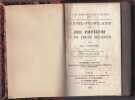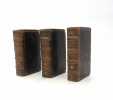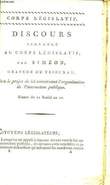-
Type
Any type (1)
Book (27927)
Disk (1)
Drawings (1)
Engraving (2)
Magazine (57)
Manuscript (7)
Music sheets (1)
Old papers (19)
Photographs (1)
Postcards (1)
Posters (2)
-
Latest
Last 24h (3)
Last 3 days (10)
Last month (365)
Last week (30)
-
Language
Dutch (4)
English (11)
French (27927)
German (7)
Italian (4)
Japanese (1)
Latin (62)
Portuguese (1)
Spanish (3)
-
Century
16th (75)
17th (362)
18th (1381)
19th (3549)
20th (7494)
21st (1943)
-
Countries
Belgium (2063)
Brazil (6)
Canada (106)
China (11)
Côte d'Ivoire (10)
Denmark (1017)
France (22312)
Germany (3)
Greece (10)
Italy (1)
Netherlands (123)
Switzerland (2358)
-
Syndicate
ALAC (105)
CLAM (109)
CLAQ (96)
CNE (5)
ILAB (17463)
NVVA (1373)
SLACES (1299)
SLAM (14883)
SNCAO (66)
Kommentar zum Schweizerischen Zivilgesetzbuch. V. Band: Obligationenrecht. Das Obligationenrecht. Bundesgesetz betreffend die Ergänzung des Schweizerischen Zivilgesetzbuches vom 30. März 1911. 4. Teil: Die Personengesellschaften Art. 530-619.
Zürich, Schultess & Co., 1938, gr. in-8vo, XX + 535 S., Stempel auf der Titel-Bl., Original-Leinenband.

(SLACES, NVVA)
Phone number : 41 (0)26 3223808
LES AIDES À L’INDUSTRIE CINÉMATOGRAPHIQUE DANS LA COMMUNAUTÉ ÉCONOMIQUE EUROPÉENNE, Préface G. Lyon-Caen, coll. Travaux et rech. de la Faculté de droit et des sc. éco. de Paris, série “Europe” n°5
, Paris, P.U.F. 1967, in-8, br., bon état, ENVOI DES AUTEURS AU PROFESSEUR RENÉ CAPITANT, 90p.


Phone number : 01 43 29 46 77
LES AIDES À L’INDUSTRIE CINÉMATOGRAPHIQUE DANS LA COMMUNAUTÉ ÉCONOMIQUE EUROPÉENNE, Préface G. Lyon-Caen, coll. Travaux et rech. de la Faculté de droit et des sc. éco. de Paris, série “Europe” n°5
, Paris, P.U.F. 1967, in-8, br., neuf, 90p.


Phone number : 01 43 29 46 77
Traité contenant la manière de procéder à toutes vérifications d'écritures contestées en justice
Ouvrage dédié à M. le Président de Bailleul volume relié in12, 180x100, relié pleine basane époque, bon état intérieur, 318pp,très rare exemplaire. A Paris, Chez Guillaume Cavelier, MDCXCIX Il était le frère du médecin et chirurgien Nicolas de Blégny. Il a été reçu en la Communauté des maîtres écrivain jurés en 1666, et exerçait à Paris dans le dernier tiers du XVIIe siècle. On a de lui un portrait gravé par Voligny en 1691. À l'occasion de la parution de Les Elémens... en 1691, il est cité comme maître écrivain dans le recueil d'adresses publié par son frère le médecin Nicolas de Blégny en 1692 sous le pseudonyme d'Abraham Du Pradel1. À cette époque, il habitait à l'entrée de la rue Saint-André [des Arcs], devant le pont Saint-Michel. Il est mort en février 1700. Il est très probablement lié à François-Étienne de Blégny, papetier, né vers 1662, demeurant également rue Saint-André-des-Arts, impliqué dans des affaires politiques et embastillé. On remarque dans ses œuvres qu'il a travaillé non seulement dans la mouvance pédagogique (écriture, arithmétique, grammaire), mais aussi dans la mouvance judiciaire, comme "juré expert établi pour vérifier les écritures". Paillasson indique que son Traité de 1699 est resté utile jusqu'à l'ordonnance de 1737 qui réforma les principes de la vérification judiciaire. ref/30
Dire de l'Abbé Sieyès sur la question du veto royal. A la séance du 7 Septembre 1789.
In-8, broché, couverture de papier marbré (rel. moderne), 32 p. Paris, Baudouin, 1789.
Edition originale. "Sieyès montre que la question du veto se rattache aussi à la théorie générale de la représentation; il se prononce contre le veto (...) dont il lie l'impossibilité à l'unité même de la volonté et de la représentation. A la hauteur où il s'élève, tous les problèmes se confondent dans une source unique. Il s'agit pour lui, non de subordonner la Nation au Roi, mais de l'unifier autour de ses députés, c'est-à-dire de son élite" (Bastid, 'Sieyes', p. 88). (Bastid, 'Sieyès', Bibliographie, n°20. Martin & Walter, 31637).Très bon exemplaire.


Phone number : 33 01 47 07 40 60
Préliminaire de la Constitution. Reconnaissance et Exposition raisonnée des Droits de l'Homme & du Citoyen.
2 parties en un volume in-8, broché, couverture de papier marbré (rel. postérieure), (2) p., 21 p. Versailles, Imprimerie de Ph.-D. Pierres, Premier Imprimeur Ordinaire du Roi (...), juillet 1789.
Edition originale de Versailles, rare, publiée en juillet 1789 par l'imprimeur ordinaire du Roi, Philippe-Denis Pierres.Un premier feuillet, non chiffré, contient une courte préface datée du 22 juillet 1789, dans laquelle Sieyès expose les conditions de rédaction et de communication de son projet de constitution, préface qu'il complète par des "Observations" au verso du même feuillet."L'essai le plus important de Sieyès du point de vue de la théorie constitutionnelle dans lequel il développe l'idée capitale du 'pouvoir constituant' " (P. Pasquino, Sieyès et l'invention de la constitution en France, p. 46 sq.).Le long "exposé des motifs" de philosophie politique est suivi des 32 articles qui constituent une véritable "Déclaration des droits de l'homme" (cf. J.-D. Bredin, 'Sieyès', p. 130).(Bastid, 'Sieyès', Bibliographie n°14. Conlon, 'Siècle des Lumières', 89:10948. Gauchet, 'Révolution des Droits de lHomme', p. 321. Monglond, I, p. 131).Auréole claire, sans gravité, au coin des deux premiers feuillets.Très bon exemplaire..


Phone number : 33 01 47 07 40 60
Vues sur les moyens d'exécution dont les représentans de la France pourront disposer en 1789.
In-8, broché, couverture papier bleu moderne, tranches jaspées, vj, 161 pages. S.l., [i.e. Paris], 1789.
Edition originale, la première des deux publiée la même année. Le texte avait été composé pendant l'été de 1788 mais la publication fut retardée et intervint immédiatement avant celle de Quest-ce que le Tiers Etat.Dans ce texte fondamental destiné à tracer l'ordre et la direction des travaux des Etats Généraux, lauteur pose leurs attributions et pouvoirs quil identifie à ceux du Tiers Etat et quil oppose aux prérogatives des privilégiés. Bastid souligne que cest ce texte auquel "Sieyès se rapportera ultérieurement plus quà aucun autre de ses autres ouvrages".(Bastid, Sieyès, Bibliographie n°4, p. 316. Martin & Walter, 31636).Bon exemplaire.


Phone number : 33 01 47 07 40 60
Dire sur la question du veto royal. à la séance du 7 septembre 1789
Paris, Baudouin, s.d. (1789) in-8, 32 pp., broché sous couverture de papier velours bordeaux postérieure.
Édition originale publiée en même temps à Versailles et à Paris. Sans surprise, le métaphysicien de la séparation des pouvoirs refusait le droit de véto au pouvoir exécutif.Martin & Walter, 31637. - - VENTE PAR CORRESPONDANCE UNIQUEMENT
Etables, granges et greniers. La conservation des bâtiments ruraux, un problème juridique. Veröffentlichungen des Instituts für Denkmalpflege an der ETH Zürich, Volume II.
Zürich et Genève, vdf Verlag der Fachvereine et Georg Editeur 1992, 295x210mm, 111pages, broché. Bel exemplaire.
photos n/b in texte, Pour un paiement via PayPal, veuillez nous en faire la demande et nous vous enverrons une facture PayPal
LA CREATION DU PREMIER ARCHEVEQUE POLONAIS A GNIEZNO ET SES CONSEQUENCES AU POINT DE VUE DES RAPPORTS ENTRE LA POLOGNE ET L'EMPIRE GERMANIQUE LA CONDITION DES PERSONNES EN FRANCE DU 9° SIECLE AU MOUVEMENT COMMUNAL (SUITE ET FIN)
LIBRAIRIE DE LA SOCIETE DU RECUEIL SIREY. 1933. In-8. En feuillets. Bon état, Livré sans Couverture, Dos satisfaisant, Intérieur frais. Paginé de 646 à 722 pages.. . . . Classification Dewey : 340-Droit
Extrait de la nouvelle revue historique de droit Français et étranger, 4° série 12° année. Publiée sous la direction de MM. J. Tardif, M. Prou, P. Dareste, P. F. Girard, P. Fournier, B. Haussoullier, Roger Grand et E. Perrot. Classification Dewey : 340-Droit
Formulaire des juges d'instruction, des juges d'instruction chargés des mineurs et de leurs délégués.
Couverture rigide. Couverture cartonnée de l'éditeur. Coiffes fatiguées. 274 pages.
Livre. Nouvelle édition entièrement refondue et complétée par Jean Aynès. Librairies Techniques, 1953.
Manuel-Formulaire Des Juges D'instruction et De Leurs Délégués - 2eme Édition
Paris Godde 1923 In12 369 pages - bien complet des planches Bertillon - Cartonnage toilé rouge - dos muet - petite réparations sur la page de titre - bon etat
Bon
L’INDUSTRIE DU MÉDICAMENT, Préface de Henri Guitton, coll. Secteur, série Perspectives de l’économique
, Paris, Calmann-Lévy 1975, in-8, br., bon état, 344p.


Phone number : 01 43 29 46 77
Les Sports Et Le Droit
De Boeck 1998 16x3x23 8cm. 1998. Broché.
Comme neuf encore sous son plastique d'emballage
SPORT EN RECHT.
, Brussel, BLOSO, 1979., linnen band met stofwikkel, in-8? , 387pp.
Deel 1: standpunten. Deel 2: positieve wetgeving.
LE DROIT COMMERCIAL AVANT ET APRES L. GOLDSCHMIDT - L'ADOPTION EN PROVENCE AU MOYEN AGE - 14°-16° SIECLE - COMPTE RENDU DE LA SEMAINE D'HISTOIRE DU DROIT NORMAND
LIBRAIRIE DE LA SOCIETE DU RECUEIL SIREY. 1934. In-8. En feuillets. Bon état, Livré sans Couverture, Dos satisfaisant, Intérieur frais. Paginé de 644 à 796 pages.. . . . Classification Dewey : 340-Droit
Extrait de la nouvelle revue historique de droit Français et étranger, 4° série 13° année. Publiée sous la direction de MM. J. Tardif, M. Prou, P. Dareste, P. F. Girard, P. Fournier, B. Haussoullier, Roger Grand et E. Perrot. Classification Dewey : 340-Droit
L’EURO. coll. Livre de poche, Inédit, Économie
, Paris, Libr. générale française 1998, in-8, br., neuf, 448p.


Phone number : 01 43 29 46 77
Le Ministre d'Estat, avec le véritable usage de la politique moderne
Amsterdam, Antoine Michiels, 1662-1664. 3 vol. in-12, [24]-488-[8] pp. + [24]-485 pp. + [24]-488-[9] pp., basane aubergine maroquinée façon long grain, double filet en encadrement sur les plats, des fleurons dorés dans les angles, dos à nerfs orné de filets et fleurons dorés, tranches dorées (petites épidermuress, dos insolés, 1 coiffe arasée, 2 trous de ver).
Nouvelle édition elzévirienne complète en trois volumes dont le premier volume a paru pour la première fois en 1631 et le dernier en 1651. Rédigé par le sieur de Silhoin, créature de Richelieu, c'est essentiellement un panégyrique de ce ministre tout-puissant. Silhon donne de nombreux exemples de politique, s'interroge sur les qualités que doit posséder un bon homme d'état ainsi que sur sa stratégie à adopter pour chaque situation. Bon état intérieur de l'exemplaire. Ex-libris gaufré Germain Malbreil. * Membre du SLAM et de la LILA / ILAB Member. La librairie est ouverte du lundi au vendredi de 14h à 19h. Merci de nous prévenir avant de passer,certains de nos livres étant entreposés dans une réserve.
EL TRIBUNAL CONSTITUCIONAL DE CHILE (1971 - 1973), coll. Estudios Juridicos n°3
, Caracas, Venezolana 1977, in-8, br., bon état, ENVOI DE L’AUTEUR, 240p.


Phone number : 01 43 29 46 77
Privilegios da nobreza, e fidalguia de Portugal, offerecidos ... Marquez de Abrantes D. Pedro de Lencastre Silveira Castello-Branco ... pelo ... Luiz Da Silva Pereira Oliveira ...
Lisboa, João Rodrigues Neves, 1806, in-8vo, XII + 344 (recte 346, nr. 303-4 used twice) + 2 leaves (errata), waterstaining to bottom margin in the first part of the volume (more important in the first 40 leaves, some tiny tears to bottom margin of prelim. part, some water staining (mainly marg.) to few leaves at the end, hw. former owner's name in bottom margin of title Gonçalo Pinto, small bookshop label on front pastedown, half leather binding, gold tooled spine, top ofspine chipped, top of hinges starting, partly rubbed and bumped.
Scarce first edition. In this guide the first part (pp. 1 to 209) deals with the origins and privileges of the various classes and kinds of Portuguese nobility "Nobreza", followed by sections such as "Das officios mecanicos incompativeis com a nobreza, e destructivos de seus brilhantes privilegios" (pp. 181-9), et "Dos crimes destruidores da nobreza". The second and third parts, with continuous pagination, deal with "Fidalgos" (pp. 211-288) and "Cavalleiros" (pp. 289-338), followed by "Leis primordiaes da nobreza Lusitana". Innocêncio noted that although the laws had been changed by his time, he still considered this an interesting and useful book. Innocêncio V/324 and XVI/71, calling for XII + 345 pp. + 3 pp. errata; not in Palha. NUC: ICN, DCU-IA, MiU, MH (calling for XII + 344 pp.).

(SLACES, NVVA)
Phone number : 41 (0)26 3223808
Considérations sur l’étude du droit annamite. 2e édition
Paris, Imprimerie nouvelle Albert Portail 1923 In-8 24,5 x 16,5 cm. Broché, couverture verte, auteur & titre en noir sur le dos et le premier plat de couverture, 480 pp., table des matières. Dos passé. Exemplaire en bon état.
Bon état d’occasion
Discours prononcé au corps législatif, sur le projet de loi concernant l'organisation de l'instruction publique, séance du 11 floréal an 10.
IMP. NATIONALE. 1802. In-12. En feuillets. Etat d'usage, Livré sans Couverture, Dos satisfaisant, Intérieur acceptable. 7 pages. Extrait d'un volume relié.. . . . Classification Dewey : 340-Droit
Corps Législatif. Classification Dewey : 340-Droit
La republique des Suisses. ... le gouvernement de Suisse, l'estat public des treize cantons, & de leurs confederez en general & en particulier, leurs balliages (sic) & iurisdictions, l'origine & les conditions de toutes leurs alliances, leurs batailles, victoires, conquestes, & autres gestes memorables, depuis l'empereur Rodolphe de Habspourg, iusques à Charles le Quint. ... mise en François. 5e édition, reveue et augmentée à la fin de quelques particularitez: spécialement d'une Exhortation aux Suisses, pour leur conservation.
(Genève), Gabriel Cartier, 1607, pt. in-8°, 8 ff., titre avec vignette gravée en forme de médaille représ. les armoiries des cantons, bas du titre abîmé et renforcé au verso autour d'une vignette gravée en forme de médaille représ. le "Rütlischwur" + 301 p. + 16 p. (table) + 1 p., vignette gravée + 1 f. bl. + 23 p. «Exhortation», page de titre avec les mêmes vignettes gravées + 1 p. illustrée d'une figure gravée sur bois représentant la tête de taureau urnoise, une de ses cornes coupée, ornée d'une bande ill. d'armoiries, une tache d'eau dans le coin inférieur, papier bruni, marge sup. coupée courte, exlibris ms. ancien à divers endroits ‘André de Praroman 1699’, ‘A.D.P.’, e.a. sur le titre général, qqs notes ms. sur l'intérieur des plats, reliure en veau, dos orné en or partiel. un peu passée, petites traces de vers au dos, qqs taches, coiffe et charnières partiel. lég. abîmées.
Histoire, antiquités, économie, droit, topographie, mœurs et coutumes; ... cet ouvrage restera le plus célèbre des manuels d'histoire suisse jusqu'au XIXe siècle. La traduction, identique à celle publiée à Paris en 1578, est attribuée, e.a., à Innocent Gentillet et à Simon Goulart.Cette 5e édition renferme une augmentation de 23 pages à la fin du volume, avec titre séparé «Exhortation aux Suisses en général pour leur conservation, contre les esmeutes & dangers du temps présent».Illustrée d'une figure gravée sur bois représentant la tête de taureau urnoise, une de ses cornes coupée, ornée d'une bande ill. d'armoiries, et avec 2 médaillons gravés, représentant les armoiries des 13 cantons / les trois "premiers savteurs de la liberté des Suisses l'an 1296". Interessant exemplaire d'association, ayant appartenue à André de Praroman.Bis 1798 blieb dieses Werk “das vollständigste Handbuch des schweizerischen Staatsrechtes” (Wyss). Barth 23685; Haller IV/409, p. 209; DHBS VI/193; Wyss, Historiogr. 210-212. Image disp.

(SLACES, NVVA)
Phone number : 41 (0)26 3223808
 Write to the booksellers
Write to the booksellers









![Vues sur les moyens d'exécution dont les représentans de la France pourront disposer en 1789.. [SIEYES (Emmanuel-Joseph)]](https://static.livre-rare-book.com/pictures/HAT/37071_1_thumb.jpg)



















